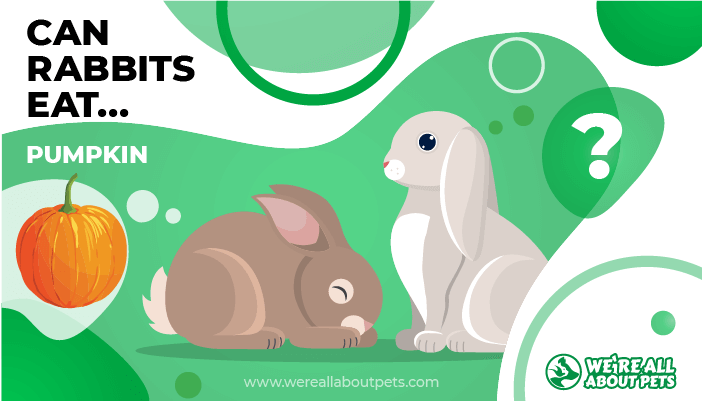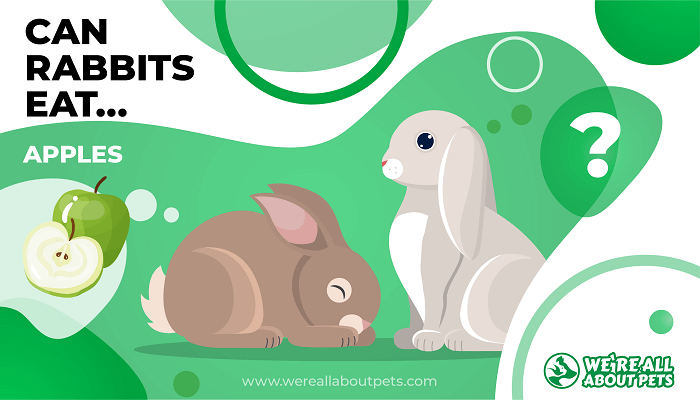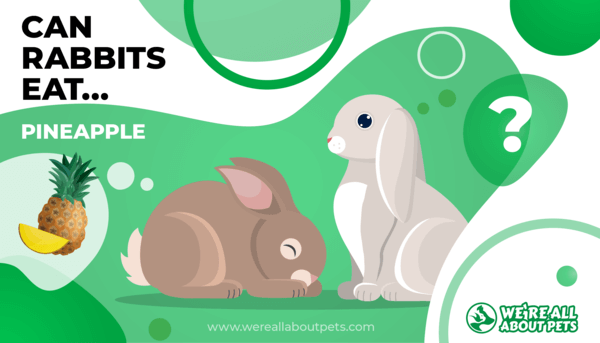What Do Rabbits Eat?
This page contains affiliate links. We may earn money or products from the companies mentioned in this post through our independently chosen links, which earn us a commission. Learn More
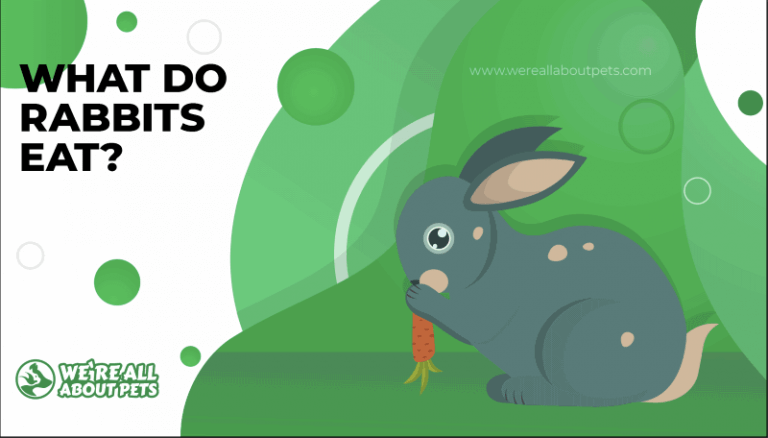
With those big floppy ears and button nose, rabbits make adorable pets. What you may not realize, however, is that rabbits are just as diverse as dogs and cats, with over 50 different breeds to choose from.
Pet rabbits have unique needs for housing and diet depending on their breed and size, though the basics for what you can and can’t feed a rabbit remain the same.
When it comes to feeding pet rabbits, nutritional needs do not vary greatly by breed. They do, however, vary depending on the rabbit’s age.
For example, adult rabbits should be fed a staple diet of grass hays with a small portion of commercial pellets and between 2 and 4 cups of fresh veggies per 6 pounds of body weight.
For young rabbits, however, alfalfa hay should be a significant part of the diet because it is rich in protein and calcium; protein and calcium are nutrients that young rabbits need for proper growth and development.
Feeding your rabbit properly will ensure that it lives a long and healthy life. With proper care, your pet rabbit could live for 7 to 10 years or more.
Read on to learn more about a rabbit’s nutritional needs and the basics about what you can and cannot feed your pet rabbit.
Types of Rabbit Diets
Rabbits are herbivores and have sensitive digestive systems. Their diet should be high in fiber, low in fat, and very low in sugar.
Fresh hay is the staple of a healthy rabbit diet, supplemented with plenty of fresh vegetables, small amounts of commercial rabbit pellets, and occasional small amounts of fruit.
Here is a quick breakdown of the various components of a pet rabbit’s diet:
- Fresh Hay – Timothy and other grass hays should make up the foundation of your rabbit’s diet. Hay helps the digestive process and keeps a rabbit’s teeth worn down. As stated earlier, adult rabbits should eat grass hays and younger rabbits should eat alfalfa hay. You can purchase fresh hay from local pet stores or order it online; just be sure that it is bright green and dry when it arrives, so you know that it is fresh.
- Commercial Pellets – Though pellets should not be a major part of your rabbit’s diet, they can help meet its requirements for fiber and boost digestion. They can also add extra vitamins and minerals to a rabbit’s diet. Be mindful that many commercial rabbit pellets are too high in alfalfa, so choose one that is timothy-based. Generally, the amount of pellets fed to a rabbit should be tapered as the rabbit reaches adulthood.
- Seed Mixes – Rabbits do not eat seeds in the wild, so commercial seed mixes are not recommended for rabbits. Your rabbit may eat some of it, but it won’t provide the kind of balanced nutrition that your rabbit needs for good health.
- Fresh Food – Fresh vegetables should be a staple of your rabbit’s daily diet. However, be sure that you refer to the lists further down in the article to see what vegetables are and are not safe for rabbits. Fresh fruit can be offered as well, but only in small quantities (2 tablespoons/6 pounds body weight/day). Make sure to wash fresh food thoroughly before feeding it to your rabbit. Feeding the fresh food while it’s still wet helps add more water to your rabbit’s diet.
- Treats – Rabbit treats should not be a major part of your pet rabbit’s diet. But, you can occasionally feed your rabbit bits of dried or fresh fruit as well as small pieces of sweet veggies like carrots or broccoli.
Now that you have a better understanding of what kind of foods you’ll be feeding your rabbit, you’re probably wondering how much to feed it. Read on to see our feeding recommendations for pet rabbits in different stages of life. Following these recommendations will help you keep your pet rabbit healthy throughout its life.
Meeting Your Pet Rabbit’s Nutritional Needs
Baby rabbits (called kits) start eating solid food very early in life – usually between 11 and 14 days. It may take until 4 to 6 weeks for them to be completely weaned, however. When they are still growing, baby rabbits require a diet that is rich in protein and calcium.
Alfalfa hay is a good source of both these nutrients, so start offering baby rabbits both fresh alfalfa hay and alfalfa pellets around 2 to 4 weeks of age. You can also feed small amounts of romaine lettuce, but avoid darker greens at this point.
Once your rabbit reaches 6 months of age, you can start easing up on the alfalfa pellets and start swapping out alfalfa hay for higher-fiber grass hays like timothy, orchard grass, and oat hay. For every 5 pounds of body weight, your rabbit’s diet should include about ¼ cup of pellets per day. After 12 months of age, rabbits should be eating a diet consisting of unlimited grass hays, 2 to 4 cups of fresh veggies, and a small portion of pellets each day.
As your rabbit gets older and you start adding more food to its diet, remember to add the new foods gradually to avoid upsetting its digestive system. If your rabbit does not like or cannot tolerate a particular food, try another food, as long as it is safe for your rabbit to eat.
To give you an idea what and how much you should be feeding your pet rabbit in different stages of life, refer to this chart:
Daily Rabbit Feeding Chart |
||||
| Age | Size | Fresh Hay | Vegetables | Pellets |
| 2 to 4 weeks | Baby | Alfalfa (small amounts) | Lettuce (small amounts) | Alfalfa-based (small amounts) |
| 1 to 6 months | Baby | Alfalfa (small amounts) | Lettuce (small amounts) | Alfalfa-based (free access) |
| 6 months | Small | Timothy and other grass hays (unlimited) | Leafy greens, vegetables, and fresh herbs (1/2 cup) | Timothy-based (unlimited) |
| 1 year to 5 years | 6 pounds | Timothy and other grass hays (unlimited) | Leafy greens, vegetables, and fresh herbs (2 to 4 cups) | Timothy-based (1/4 to ½ cup) |
| 1 year to 5 years | 10 to 12 pounds | Timothy and other grass hays (unlimited) | Leafy greens, vegetables, and fresh herbs (3 to 5 cups) | Timothy-based (1/2 cup) |
| Over 6 years | 6 pounds | Timothy and other grass hays (unlimited) Add some alfalfa hay if underweight | Leafy greens, vegetables, and fresh herbs (2 to 4 cups) | Timothy-based (1/4 to ½ cup)
Add some alfalfa pellets if underweight |
| Over 6 years | 10 to 12 pounds | Timothy and other grass hays (unlimited) Add some alfalfa hay if underweight | Leafy greens, vegetables, and fresh herbs (3 to 5 cups) | Timothy-based (1/2 cup) Add some alfalfa pellets if underweight |
Understanding your rabbit’s nutritional needs is important, but you also have to make smart choices about the way you meet those needs. Fresh hay and vegetables should be the staple of your pet rabbit’s diet, but commercial pellets can help balance out its nutrition. Read on to see our recommendations.
Recommended Commercial Rabbit Foods
When it comes to choosing commercial pellets for your rabbit, you need to remember that rabbits are herbivores. In their natural diet, they rarely eat fruits, nuts, and seeds, so these foods should not be included in your rabbit’s commercial food mix.
A high-quality rabbit pellet should contain at least 22% crude fiber with no more than 14% protein, 1% fat, and about 1% calcium. Check the label to make sure the pellets are primarily timothy hay-based, not alfalfa hay-based.
Here are some of our top picks for the best commercial rabbit food:
- Oxbow Essentials Young Rabbit Food – Formulated for juvenile rabbits, these pellets offer a high concentration of protein, fiber, and other essential nutrients.
- Small Pet Select Rabbit Pellets – Featuring timothy hay as the primary ingredient, these fiber-rich pellets are a little more expensive, but the quality is worth it for your rabbit’s nutrition.
- Science Selective Adult Rabbit Food – Made with moderate protein levels and plenty of fiber, these alfalfa hay-based pellets are ideal for adult and senior rabbits who need to put on weight.
Looking for more recommendations on what pellets to feed your rabbit? Check out our in-depth guide to the best commercial rabbit foods.
Safe And Unsafe Foods For Rabbits
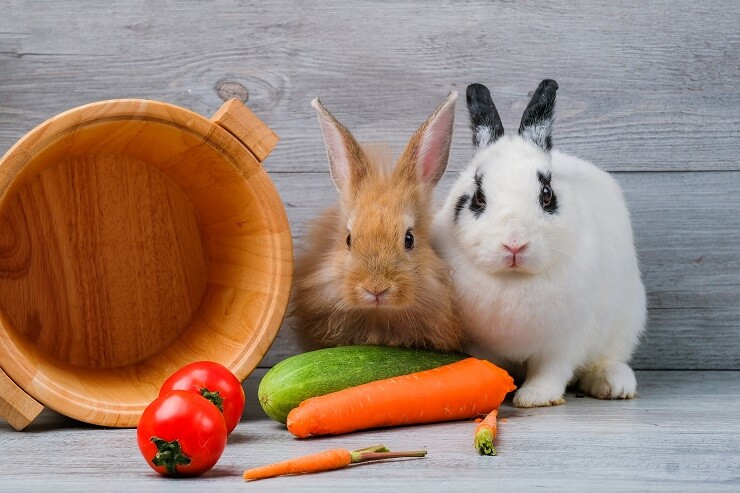
Now that you know about the essentials of a pet rabbit’s diet, you may be wondering what specific foods your rabbit can and can’t eat. We’ve assembled a list of dozens of foods that are and aren’t safe for your rabbit. Check them out below!
Vegetables, Fruits & Foods That Are Safe for Rabbits:
The best foods for your rabbit are fresh hays and vegetables. Timothy hay should be the staple of your rabbit’s diet, supplemented with other grass hays like orchard grass and oat hay.
You can also feed your rabbit fresh vegetables from the list below on a daily basis:
- Timothy hay
- Orchard grass
- Oat hay
- Timothy hay pellets
- Bell peppers
- Brussels sprouts
- Carrot tops
- Celery
- Cucumber
- Endive
- Fennel
- Fresh herbs
- Leafy greens
- Radish tops
- Sprouts
- Watercress
- Wheatgrass
- Zucchini
Foods Rabbits Can Eat in Moderation:
Adult rabbits should eat a diet consisting primarily of fresh hay, timothy pellets, and fresh vegetables but younger rabbits can eat alfalfa hay and alfalfa pellets. High-fiber fruits like apples and plums can be offered in small amounts (1 to 2 tablespoons) a few times a week along with other fresh fruits, dark greens, and high-sugar vegetables like carrots.
- Alfalfa hay
- Alfalfa pellets
- High-fiber fruits (like apples & plums)
- Fresh carrots
- Broccoli stems and leaves
- Chard
- Clover
- Collard greens
- Dandelion greens
- Edible flowers
- Kale
- Spinach
- Seedless cherries
- Banana
- Nectarines
- Melon
- Oranges
- Papaya
- Peaches
- Pears
- Pineapple
- Watermelon
Foods That Are Not Recommended for Rabbits:
Rabbits are strict herbivores, so you should never feed your rabbit nuts and seeds or dried fruit. High-carb foods and sugary foods are also not recommended for rabbits. Here are some others:
- Dried corn
- Nuts and seeds
- High-carb foods like bread and cereal
- Sugary foods
- Large amounts of fruit
- Iceberg lettuce
- Pasta
- Yogurt
Foods That Are Toxic for Rabbits:
When feeding your rabbit, make sure you do not feed him any seeds or pits when offering fruit. You should also avoid the following foods that are unsafe or toxic for rabbits:
- Avocado
- Broad beans
- Garlic
- Leeks
- Chocolate
- Legumes
- Peanuts
- Onions
- Peas
- Potatoes
- Rhubarb
- Sweet potatoes
- Shallots
- Chives

By now, you probably have a good understanding of the basics about feeding your pet rabbit, but we understand if you still have a few questions.
Here are the answers to some commonly asked questions about rabbits:
Rabbit Feeding FAQs
What do rabbits eat in the wild?
Wild rabbits thrive on a variety of types of plants including wild grasses, leaves, and shoots. In the winter, they may also eat evergreen needles and bark to supplement their diet.
How much do rabbits eat?
Hay should make up 80% to 90% of your rabbit’s diet, so offer it in unlimited amounts. In addition to hay, your rabbit should eat 2 to 4 cups of fresh vegetables per day for large rabbits and 1 to 2 cups for small rabbits.
Offer 2 to 3 kinds of vegetables each day. Timothy hay pellets should also be part of your rabbit’s diet and most rabbits eat ¼ cup of pellets. For rabbits under 5 pounds, feed 2 tablespoons.
What do rabbits drink?
Hydration is very important for rabbits and it plays a key role in healthy digestion. You should provide your rabbit with unlimited amounts of fresh water, changing the water once or twice daily.
Offer your rabbit fresh water in a bowl or a bottle. If using a bowl, be sure to clean it often because it may become dirty with pellets or hay. If using a water bottle, be careful to clean it well with soap and water every few days.
Do rabbits eat insects?
No, rabbits are strict herbivores which means that they only eat plant foods.






